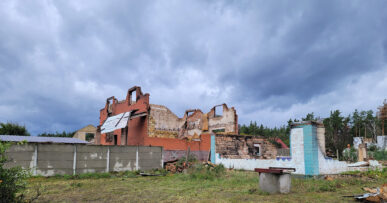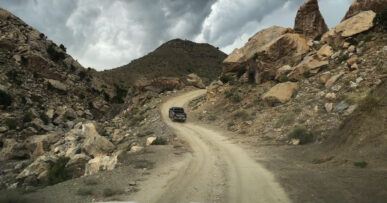- The 2010 Haiti Earthquake, Part 1
- The 2010 Haiti Earthquake, Part 2
- Miyamoto in Haiti: The Presidential Palace, A Fractured Haitian Icon
- Miyamoto in Haiti: Damage Assessment of the Japanese Embassy
- Miyamoto in Haiti: The Well-Oiled Relief Machine Rolling Through Haiti
- Miyamoto in Haiti: Inside a Heavily Damaged Building
- Miyamoto in Haiti: Visiting The Citadel
- Thirty Months in Haiti, Part 1
- Thirty Months in Haiti, Part 2
- Thirty Months in Haiti, Part 3
- Miyamoto in Haiti: A Morning and Afternoon of Hopeful Rebuilding
- Miyamoto in Haiti: School Rebuilding and Construction Continues
- Trente mois en Haïti, 1eme partie
- Trente mois en Haïti, 2eme partie
- Trente mois en Haïti, 3eme partie
- Miyamoto in Haiti: Visiting a Remote School Construction Site Near Cap-Haïtien
- Miyamoto in Haiti: Self-Sustaining Relief
- Miyamoto in Haiti: Love it or Hate it? Love it!
- Miyamoto in Haiti: Lycee de Cite Soleil Rehabilitation Project
- Miyamoto in Haiti: The Hopeful Road to Recovery
- A Day in the Haiti Disaster Zone
- Kidnappers & Disaster
- A Disaster Week in Haiti
Haiti – January 20, 2010
At 2 am I wake up to the sound of a shot gun blast outside of the house I am staying in. Well, this is the first time in my life I have ever been woken up by the sound of gunshot. I slowly spy from the back yard window to investigate. It is strange and silent. No one is visible. So I decide to go back to sleep. As I fall asleep again, I begin thinking about the 4000 criminals who have escaped from the damaged jail. As you might suspect, the surrounding community is very concerned.
Gentle swings of a magnitude 6.1 aftershock wake me again at 6:03 am. Surprisingly, I am not afraid, nor worried and almost comforted by the feeling of the motion. being swung. The house that I am in withstood a magnitude 7 earthquake a week ago. This house should be fine for weaker aftershocks. After eating stale raisin flakes with old milk, we leave for the PADF office.

In the morning light, the destruction is highly visible. A refuse camp with a pile of rubbish, cars squashed under buildings with victims still inside, people digging through piles of concrete for missing family and friends with little or no tools, twisted metal and concrete is everywhere, a distant hillside slum turned into total devastation. All of these visuals are wrapped with the smell of car exhaust and death. The smell of death reminds me of past disaster sites. It is a strange, tangy, sweet smell. Once you smell it, it stays with you and lingers in your nose for many hours. Soon the morning fresh feeling slowly turns into depression.
At the PADF office, I meet with a World Bank officer who was asked by the finance ministry to investigate their buildings. I hop into his truck with my team. Guilaine, is a human rights attorney who volunteers as a translator—she is a quick thinking and witty Haitian. Eric, an ex-Haitian cabinet member, is a PADF consultant who is well connected with the local community. Paul is a Haitian cameraman. Our driver maneuvers through the debris-filled city. He has to backtrack many times to avoid the debris blocked and traffic-jammed roads. We enter the devastated downtown.
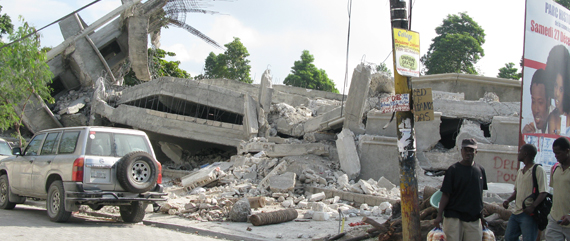
The destruction from the earthquake was complete. It is like a scene from an Apocalypse. I see blown up buildings, smashed concrete, a collapsed national symbol and a lost presidential palace. And, always, the dusty smell of death and bloodstained clothes. But, there is something even more strange about this picture. I don’t see any heavy equipment in the entire downtown area. This earthquake struck one week ago and the collapsed buildings remain fresh and untouched, as if the event just occurred. I have never seen anything like this in all the disaster sites I have visited.
What is going on?
This earthquake has wiped out many governmental buildings and its functionality is reduced significantly. This area is close to the ocean and therefore the soil is soft. Soft soil amplifies ground motions and higher, amplified ground motions have a destructive effect on weak buildings. These buildings are typically made of non-ductile concrete with unreinforced concrete blocks; a lethal combination for earthquakes. I would estimate that 50% of the buildings have collapsed or are heavily damaged in this heartbroken area. We knew this was one of the most dangerously earthquake vulnerable areas in the world. If we had been able to seismically strengthen these critical structures, such as the emergency command centers, key government buildings, hospitals, schools, jails, port, airport, and the UN headquarters, the post-earthquake response would be totally different.
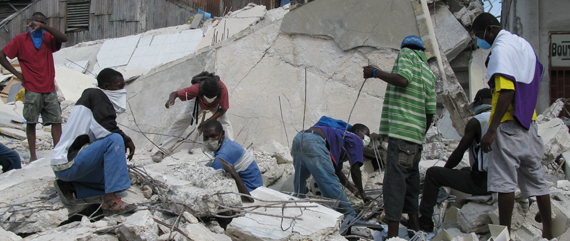
Why are we, engineers failing to inform our societies again? I have seen the same exact failures at recent earthquakes in L’Aquila, Italy and Sichuan, China. As an engineer, it is frustrating for me to see this level of destruction. If the building code and engineering practices addressed earthquakes, then the magnitude of the death toll would be much less.
The World Bank officer takes me to the building that belongs to one of the financial ministry agencies. This is a small one story building, with an essential function. It is responsible for the national financial plans. The director meets me at the front of the building. As usual, I see a guard armed with a shot gun; I ask him to pose for a picture. He quietly complies with a smile. We walk through the building and we find minor cracks in some sections. I specify the locations that can and cannot be occupied. The director is relieved to hear the recommendations. He and his staff can now go back to work.
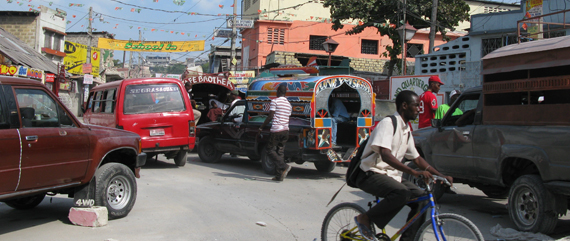
We drive through debris-filled streets to the nearby Financial Ministry building. It is a large two-story, heritage building. Its second floor walls have completely failed and collapsed onto the cars below. A section of the roof is totally unsupported because of the failure, but somehow it has not yet collapsed. Besides this spectacular failure, the building seems intact. I meet a finance director who asks me, “Can our staff go into the basement to retrieve very important IT information?” I say “Well, I need to go to the basement to see the damaged level.” So I put my headlamp on and take off with his IT staff to the basement. It is a treacherous trail. We have to maneuver around crushed cars, and a pile of concrete just to enter the building. Since the main steel door to the basement vault is locked from the inside, we have to climb through a window to enter the building. The basement is in total darkness, but my headlamp illuminates the undamaged equipment and structural area. After looking through the basement quickly, we trace our steps back to the surface where the sun is bright. I describe a safe path to the basement vault.
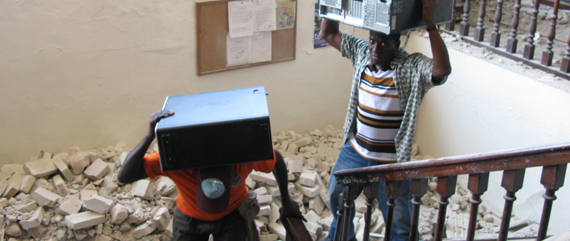
While I celebrate with high fives together with my Haitian team, the director says, “Well, Kit. I have another request. Our National Budget is in the hard drive on the second floor of this building.” I ask a stupid question, “How important is it?” He just looks at me with a wide smile and says “extremely!” Again, I carefully find a safe path through the blown up structure and lead a quickly assembled special documents retrieval team to rescue the National budget. After struggling through the jammed doors, we find the hard drives. Once there, we decide to carry everything out ourselves. I do not see the need for anyone else to come up here again and take additional risks. My Haitian teammates are reliable men and they carry the large and heavy units on their heads. One guy almost trips and the hard drive slips from his hands while he is climbing down the stairs over broken bricks and wood beams. At the last second, he catches the hard drive with his two seemingly sticky fingers. These guys are good!

When we come out, I notice the CNN crew videotaping our struggle. The director is full of smiles and gratitude for our efforts. Even a small feat like this makes me feel like we saved some lives today indirectly. Without the national budget, it would be very difficult for the government to conduct the fast recovery effort needed in this unprecedented disaster. Afterwards, CNN interviews me briefly. We say goodbye to the finance ministry.
We drive through the destruction to a modern downtown hospital. As we enter the crowded hospital, I see a little boy of about five with half of his leg lost wrapped in bloodstained cloth laying in the hall way with his mom. He smiles at me with his big brown eyes. I see a pretty little girl about 10 years old, sleeping on a stretcher in the hallway. I look down and notice her foot where bone is exposed and a portion of muscle is missing. I have small children too and they remind me of them. It is a heartbreaking sight. This is part of the horror. Earthquakes not only kill, but shatter the lives of countless people, including children, who are often maimed and gravely injured.
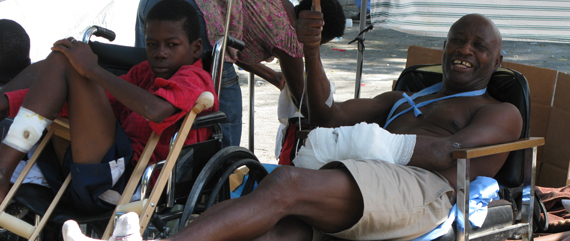
I meet a hospital owner who shows me damaged columns. I give him technical advice about the damage and the shoring he will need to provide. I also meet a volunteer, an American MD from Colorado. These guys are working countless hours to save people. He shows me a 10 foot by 10 foot waiting room where he and a couple of his colleagues sleep. He says, “We still have a shortage of medical supplies and I had to go to the airport this morning to scavenge for supplies.” I ask, “What happened? Why are they not distributing the supplies?” He simply says, “Bureaucracy.” I am depressed and begin walking towards the door. An injured Haitian man gives me a big smile and thumbs up. One of thing about Haitians, they smile so brightly no matter what condition they are in. A brave people they are.
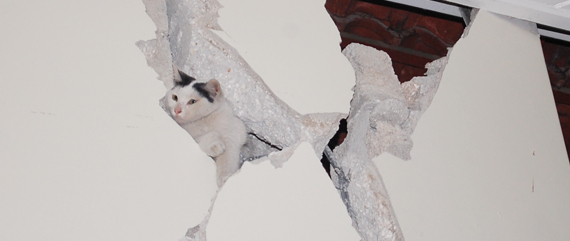
For the rest of day, we are called upon to investigate a couple of commercial hotels. One hotel has only several minor cracks in the concrete block walls, but the owner decided to close down. I tell the owner that it is ok to re-open the hotel with some repairs. Another hotel has severe damage in some areas. This owner shut down most of the damaged area, but the pool bar right next to the collapsed roof is still open. It is an amazing scene of a tranquil pool bar filled with journalists and guests typing away on their laptop just 20 feet away from incredible destruction.
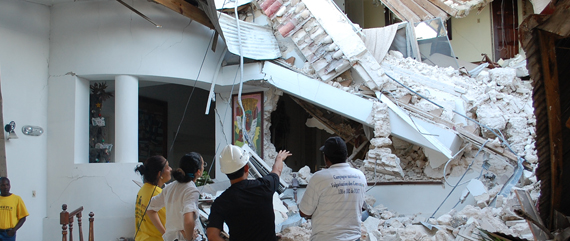
I advise the owner to close the pool bar because of the potential falling hazard from the collapsed roof. Post-earthquake damage assessment by trained structural engineers is very important. If this earthquake had happened in the US or Japan, thousands of engineers with green, yellow, and red tags would have descended upon the scene to evaluate structural safety. I believe this system saves lives and speeds up the recovery effort. Every country with any natural hazard risk should adopt this type of emergency inspection system.
As the red sun sets, I reconvene with Dan and Daniel at the PADF office. They have been busy all day preparing the logistics and office to receive the relief supply. They have secured the warehouse spaces and everything is ready. It is unglamorous, 15 hour days of tough work, but logistics are so critical. After all, logistics failures contributed to the high death toll from this earthquake.
We drive back in the darkness.
